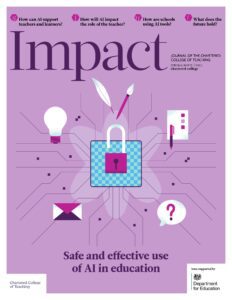AI for schools: Unlocking potential in curriculum processes
Charlie Cutler, Director of Curriculum, United Learning, UK
Generative artificial intelligence (GenAI) has the potential to fundamentally change education and substantially support teachers in teaching, and its use in education is growing. The proportion of teachers reporting using GenAI ‘to help with school work’ has grown from 35 per cent in August 2023 to 42 per cent in November 2023 (Teacher Tapp, 2023) and to 57 per cent in August 2024 (Teacher Tapp, 2024).
The ways in which teachers might use GenAI ‘to help with school work’ are varied, from drafting policies to communicating with parents. However, as of April 2023, the most common-use cases were ‘creating lessons/curriculum resources’ (reported by 62 per cent of teachers surveyed) and ‘planning lessons/curriculum content’ (42 per cent) (DfEDepartment for Education - a ministerial department responsible for children’s services and education in England, 2024a).
These figures may be a result of – or have resulted in – a parallel growth in the number of GenAI tools that aim to support teachers with these curriculum- and lesson-based tasks. These include tools that create resources, lesson plans and unit plans, and even tools that generate end points.
But without a common understanding of the role of GenAI in curriculum processes, the use of these tools is limited and could, perhaps, be detrimental.
This article will firstly set out a model for effective (and ineffective) GenAI use in curriculum processes, and secondly consider how we may need to change the way in which we store curriculum information to fully unlock the potential of GenAI in this aspect of teachers’ work.
1. Effective use of GenAI in curriculum processes
In describing the use of GenAI, different reports will use terms like ‘planning’ and ‘resourcing’ differently; it is important to be clear about what we mean when using these terms.
Figure 1 presents a very simple model of core curriculum processes for the purposes of this article. It is limited: it does not include consideration of pedagogical approaches, nor the formative assessment of pupils’ understanding and subsequent planning and preparation to fill gaps in knowledge. This is not because these are not integral aspects of teachers’ work, but because the role of GenAI in these areas would require separate articles and cannot be considered here. (Formative assessment and planning gap-filling tasks were the subject of the technical proof of concept in a hackathon commissioned by the Department for EducationThe ministerial department responsible for children’s services and education in England, which was published in October 2024 (DfE, 2024b).)

Figure 1: A simple model of core curriculum processes
Broadly, we should consider planning as the consideration of what content will be taught and how this will be carefully sequenced to enable pupils to develop their schemas over time. Long-term curriculum design includes an articulation of the key concepts that should be developed in a subject (and across subjects) over a long period over time, typically over years and key stages. Medium-term planning includes the sequencing of content over a series of lessons or a unit, and short-term lesson planning will include decisions about how an individual lesson will build in small steps, and how individual pupils may need to be supported with scaffolds or other structures. Planning needs to happen in this order: it is not possible to develop a lesson outline without a clear understanding of where that content will sit in the medium- and long-term curriculum sequence.
Only once all the stages of this planning are complete can teachers turn to preparation, or the creation of resources that will enable teachers to deliver the lesson itself. This may include writing appropriate texts for students to read, locating historical sources, writing questions, translating texts and writing model answers. These resources are typically created for specific purposes and designed according to the parameters of the lesson outline.
It is in the preparation – the short-term lesson resourcing – where GenAI is currently most useful and effective. With specific prompts, teachers can use readily available tools to create specific diagrams, texts and translations. With a lesson outline in mind, teachers can generate resources to a clear brief. Research commissioned by the Department for Education showed that using GenAI for ‘generating lesson materials’ saved time, met national standards and improved outcomes, and the participants involved in the research said that they would be likely to use it for this purpose (DfE, 2024c).
In contrast, the sector should seriously consider how GenAI could play a role in long-term curriculum design – if at all – both now and in the future. At its core, this part of the process involves making decisions about what we choose to teach pupils and what we as a society and in our schools agree is the ‘powerful knowledge’ that will enable pupils to think and act more powerfully in their lives (Young et al., 2014). Delegating this task to GenAI – to tools that are widely known to generate content that can be inaccurate, inappropriate, biased, taken out of context, out of date or unreliable (DfE, 2023) – does not sit comfortably. We should also be mindful that the majority of GenAI tools have been created in the USA, so are not typically tailored for educators in the UK or England. Tools like an ‘endpoint generator’ should therefore be used with caution, if at all.
There are many tools currently available for other stages of planning – the medium-term outlines and short-term lesson outlines – notably the DfE-funded Oak Academy’s Aila. Like many other tools, this aims to enable teachers to ‘build a tailor-made lesson plan and resources in minutes’ (Oak National Academy, 2025). However, DfE-commissioned research shows that teachers did not feel that using GenAI for ‘generating age-appropriate lesson plans’ resulted in usable resources that would improve outcomes (DfE, 2024c, p. 22).
This finding is not surprising. Many GenAI tools available to teachers promote a focus on generating a short-term lesson outline, in isolation from the long-term curriculum design and medium-term outlines. GenAI tools in their current format – not trained on any one coherent curriculum sequence – cannot generate a lesson that will sufficiently build on prior learning, use appropriate vocabulary and achieve the objectives of a lesson in appropriately sized steps.
2. Maximising the impact of GenAI
In their current format, GenAI tools cannot generate medium-term and short-term lesson outlines as effectively as teachers. Teachers have the knowledge of what has been taught previously, how knowledge will build in the future and the specific outcomes that need to be mastered to enable pupils to progress in the wider curriculum sequence. GenAI does not have this contextual curriculum information, and can therefore only generate a generic lesson outline based on the information on which it has been trained.
At United Learning, we have been experimenting with how we can give GenAI the contextual curriculum knowledge that it needs in order to improve the quality and relevance of what it can generate.
Providing this curriculum information is not straightforward, for two reasons. The first is the practical question of how to feasibly collate and store all the information in a given curriculum in one place, from the progression in key concepts, to specific vocabulary and definitions, to the ways in which pupils might be expected to apply their knowledge in different contexts. The second challenge is how to give this information to a GenAI tool safely. Often, anything uploaded to a tool will be incorporated into its broader training dataset and used to further train the model. This has implications for the quality of the tool’s outputs: if lots of inaccurate or ineffective items from different sources are incorporated into the dataset, the tool will learn from them and subsequently generate increasingly inaccurate or ineffective outputs. It also has implications for the owner of the intellectual property of the curriculum (typically the school or trust in which they were created), who lose exclusivity.
Our early experiments have aimed towards overcoming these two challenges. To collate and store curriculum information, we have taken all our content and sequencing information that currently sits in Microsoft PowerPoints, Word documents and Excel files, and stored it all as a Microsoft Azure Blob (binary large object). This is like a folder structure that allows us to store files with useful ‘tags’ (metadata) such as phase, subject, topic, key stage and so on. From there, we can extract all the core content contained within the files and create a single Azure Search Index. This is a large single library of curriculum information with associated metadata, with which a GenAI tool can interact.
To overcome the second challenge and ensure that this curriculum information is safe, we have limited our use of GenAI to Microsoft’s Azure OpenAI service. This is secure; the service does not share data with other sources or tools, or use our information to further train its model.
These early experiments have shown that it is possible to generate outputs that are aligned to a specific curriculum sequence. For example, if asked ‘What do pupils learn about river processes in Year 7?’, it can give accurate information about the specific vocabulary used, the specific features that are included and, when prompted, how this will build in the future – which is a significant improvement on the responses of the widely available generic tools.
Larger education institutions, multi-academy trusts and EdTech companies are likely to have more technical expertise and capacity to conduct experiments like this. But to enable all schools to harness the potential of GenAI in curriculum processes, we need a more scalable way of enabling individual schools to store and utilise their curriculum information. This is a longer-term goal and a challenge for the sector as a whole, which will require collaboration between educators and those with more technical expertise.
In the meantime, we should not stop setting out our expectations for GenAI and where it can and cannot help us in curriculum processes. By defining our expectations and collaborating as a sector, we can ensure that GenAI tools enhance, rather than dictate, our approach to curriculum processes.
The examples of AI use and specific tools in this article are for context only. They do not imply endorsement or recommendation of any particular tool or approach by the Department for Education or the Chartered College of Teaching and any views stated are those of the individual. Any use of AI also needs to be carefully planned, and what is appropriate in one setting may not be elsewhere. You should always follow the DfE’s Generative AI In Education policy position and product safety expectations in addition to aligning any AI use with the DfE’s latest Keeping Children Safe in Education guidance. You can also find teacher and leader toolkits on gov.uk .
- Department for Education (DfE) (2023) Generative artificial intelligence (AI) in education: Policy paper. Available at: www.gov.uk/government/publications/generative-artificial-intelligence-in-education/generative-artificial-intelligence-ai-in-education (accessed 17 January 2025).
- Department for Education (DfE) (2024a) Generative AI in education: Educator and expert views. Available at: https://assets.publishing.service.gov.uk/media/65b8cd41b5cb6e000d8bb74e/DfE_GenAI_in_education_-_Educator_and_expert_views_report.pdf (accessed 17 January 2025).
- Department for Education (DfE) (2024b) Use cases for generative AI in education: Building a proof of concept for Generative AI feedback and resource generation in education contexts: Technical report. Available at: https://assets.publishing.service.gov.uk/media/671108a18a62ffa8df77b2bf/Use_Cases_for_Generative_AI_in_Education_-_Technical_report_October_2024.pdf (accessed 17 January 2025).
- Department for Education (DfE) (2024c) Use cases for Generative AI in education: User research report. Available at: https://assets.publishing.service.gov.uk/media/66cdb078f04c14b05511b322/Use_cases_for_generative_AI_in_education_user_research_report.pdf (accessed 17 January 2025).
- Oak National Academy (2025) AI experiments: Introducing Aila. Available at: https://labs.thenational.academy (accessed 17 January 2025).
- Teacher Tapp (2023) How to improve behaviour and wellbeing, and how you're using AI in schools. Available at: https://teachertapp.com/uk/articles/how-to-improve-behaviour-wellbeing-and-how-youre-using-ai-in-schools (accessed 17 January 2025).
- Teacher Tapp (2024) AI teachers, schools exclusions and cutting workload. Available at: https://teachertapp.com/uk/articles/ai-teachers-school-exclusions-and-cutting-workload/#AI (accessed 17 January 2025).
- Young M, Lambert D, Roberts C et al. (2014) Knowledge and the Future School: Curriculum and Social Justice. London: Bloomsbury.










